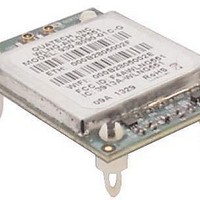WLNG-SE-DP551 Quatech, WLNG-SE-DP551 Datasheet - Page 26

WLNG-SE-DP551
Manufacturer Part Number
WLNG-SE-DP551
Description
WiFi / 802.11 Modules & Development Tools WIRELESS DEV SERVER RS-422/485 SUPPORT
Manufacturer
Quatech
Series
Airborne™r
Specifications of WLNG-SE-DP551
Wireless Frequency
2.48 GHz
Interface Type
UART
Modulation
DBPSK, DQPSK, CCK, BPSK, QPSK, 16QAM, 64QAM
Security
64/128 bit WEP, WPA, AES, EAP
Antenna
U.FL
Operating Temperature Range
- 40 C to + 85 C
Mfg Application Notes
Transition to DP550 Devices AppNote
Frequency
2.4GHz ~ 2.4835GHz
Data Rate - Maximum
54Mbps
Modulation Or Protocol
802.11 b/g
Applications
WLAN
Power - Output
-
Sensitivity
-98dBm
Voltage - Supply
3.3VDC
Current - Receiving
310mA
Current - Transmitting
240mA
Data Interface
Connector, 36 Pin Header
Memory Size
-
Antenna Connector
U.FL x 2
Operating Temperature
-40°C ~ 85°C
Package / Case
Module
Lead Free Status / Rohs Status
Details
For Use With/related Products
ARM 9, AR6002
Quatech, Inc.
8.0
26
Antenna
The unit supports antenna connections through two Hirose U.FL connectors (CN2 and
CN3), located on the top surface of the device next to the RF shielding. The device
supports both transmit and receive diversity. Antenna selection and diversity options are
selectable through both the web and command line interfaces.
Any antenna used with the system must be designed for operation within the 2.4GHz
ISM band and specifically must support the 2.412GHz to 2.482GHz for 802.11b/g
operation. They are required to have a VSWR of 2:1 maximum referenced to a 50
system impedance.
8.1
8.2
Antenna Selection
The Airborne radio supports a number of antenna options, all of which require
connection to the U.FL connectors on the radio. Ultimately the antenna option
selected will be determined by a number of factors, these include consideration
of the application, mechanical construction and desired performance. Since the
number of possible combinations is endless we will review some of the more
common solutions in this section. If your application is not covered during this
discussion please contact Technical Support for more specific answers.
The available antenna connections include:
In addition to the above options, location and performance need to be
considered, the following sections discuss these items.
Host Board Mounted Antenna
Host board mounted requires that an antenna connection is physically mounted
to the host system board. It also requires that the host board include a U.FL
connector (two (2) if diversity is being used) to allow a U.FL to U.FL coaxial lead
to connect from the radio to the host board. It will then require 50 matched PCB
traces to be routed from the U.FL connector to the antenna mount.
There are several sources for the U.FL to U.FL coaxial cable these include
Hirose, Sunridge and IPEX. Please contact Quatech for further part numbers and
supply assistance.
This approach can simplify assembly but does require that the host system
configuration can accommodate an antenna location that is determined by the
host PCB. There are also limitations on the ability to seal the enclosure when
using this approach.
This approach also restricts the selection of available antenna. When using this
approach, antennas that screw or press fit to the PCB mount connector must be
Host board mounted antenna
Host chassis mounted antenna
Embedded antenna
4/14/2011
100-8090-100




















